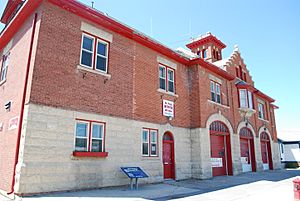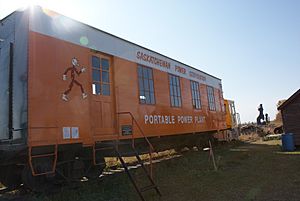1950 Red River flood facts for kids
| Date | April 15–June 12, 1950 |
|---|---|
| Location | Wahpeton - Breckenridge Fargo - Moorhead Grand Forks - East Grand Forks Oslo, Minnesota Pembina, North Dakota Winnipeg, Manitoba |
| Deaths | Canada: 3 United States: 5 |
| Property damage | $600 million -$1 billion |
The 1950 Red River flood was a very big flood that happened along the Red River. It affected areas in North Dakota, Minnesota, and Manitoba, Canada. The flood lasted from April 15 to June 12, 1950.
The city of Winnipeg, Manitoba, was hit especially hard. On May 5, the city was covered in water. Some people called this day Black Friday because of how bad it was.
About 70,000 to 100,000 people had to leave their homes. Four out of eleven bridges in the area were broken. The Red River reached its highest level since 1861. It flooded a huge area called the Red River Valley, over 1,424 square kilometers (550 square miles).
Sadly, eight people died because of the flood. The flood caused a lot of damage, costing between $600 million and over a billion dollars. To stop such big floods from happening again, the government built the Red River Floodway. This project was finished in 1968. It has saved the area from over $100 billion (Canadian dollars) in flood damage since then.
Contents
How the Flood Started
Seasonal floods were common along the Red River. But the 1950 flood was much worse than others. It happened because of two main reasons. First, there was a lot of heavy snow during the winter. When this snow melted in the spring, it added a huge amount of water to the river.
Second, there were very heavy rains in the spring. This rain also flowed into the river. The Red River flows north, so ice jams can form easily. All this water caused the river to overflow its banks.
Winnipeg's Struggle
The flood was very serious for Winnipeg. Eight dikes, which are walls built to hold back water, broke. This caused a large part of Winnipeg to flood. About 1,554 square kilometers (600 square miles) of farmland turned into a giant lake. The water on the farmland was between 0.6 to 1.8 meters (2 to 6 feet) deep.
The city asked for help from the Canadian Army and the Red Cross. They worked together to help people.
In Winnipeg, one person died. Almost 100,000 people had to leave their homes and businesses. This was the biggest evacuation in Canadian history until 1979. The damage to homes and businesses was huge. It cost between $600 million and over a billion dollars.
Building the Red River Floodway
Because of the massive damage, the government decided to build the Red River Floodway. This is a large channel that helps move floodwaters away from Winnipeg. It sends the extra water to other parts of the river.
The Floodway was finished in 1968. It has been used 20 times since then to prevent floods. For many years, people jokingly called it "Duff's Ditch." This was after the premier, Dufferin Roblin, who helped build it.
The Floodway has prevented over $100 billion (Canadian dollars) in flood damage. In 2000, it was named a National Historic Site of Canada. It is seen as an amazing engineering success.
Impact in the United States
The Red River Valley in the United States also experienced severe flooding. Five people died in the United States because of this flood.



